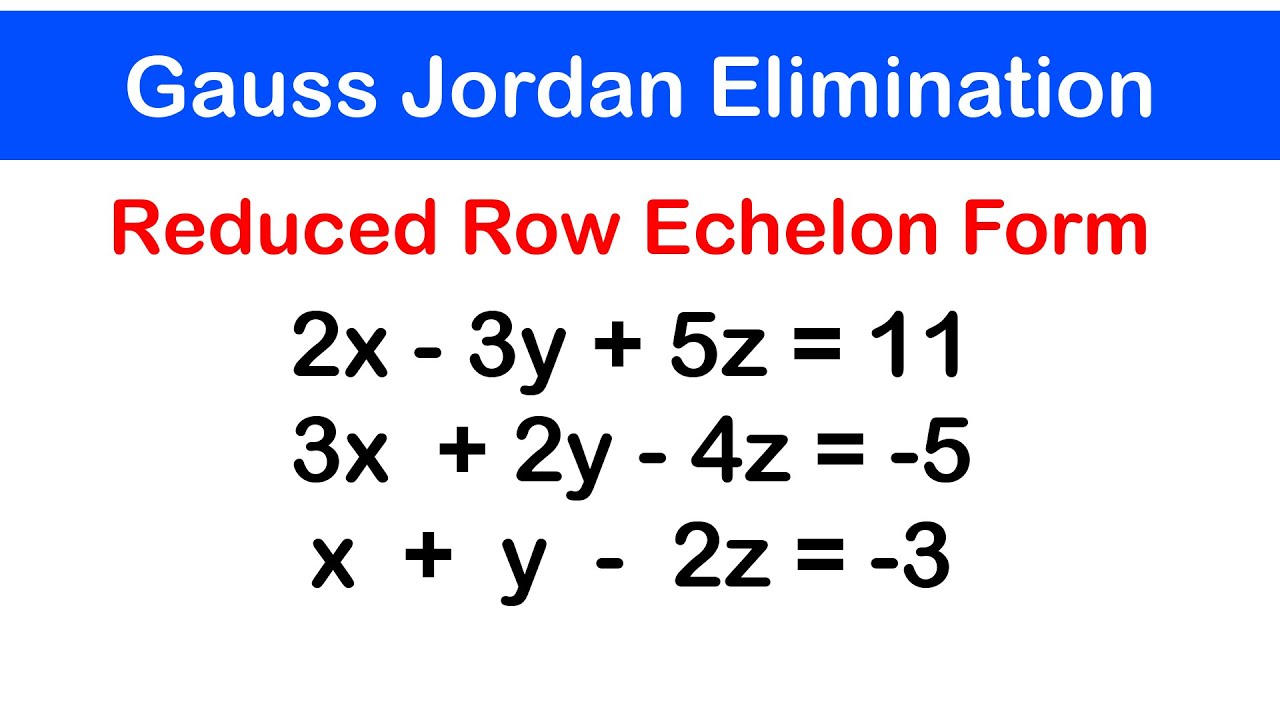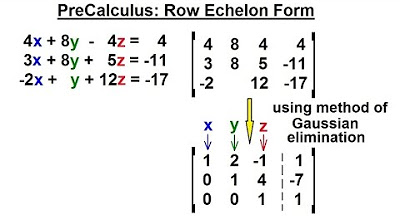Gauss-Jordan Elimination
TLDRThis video tutorial delves into the Gauss-Jordan elimination method, a linear algebra technique for solving systems of linear equations. It offers a step-by-step guide, starting with writing the augmented matrix and progressing through the elimination process to achieve a reduced row echelon form. The presenter emphasizes the method's advantage of providing direct answers without the need for algebraic substitution, despite the potential for computational errors due to rounding. The video concludes with a clear solution to the example system, showcasing the power of the Gauss-Jordan method in obtaining precise results.
Takeaways
- 📚 Gauss Jordan elimination is an extension of Gaussian elimination, used to solve linear equations without the need for algebraic substitution.
- 🔍 The final matrix in Gauss Jordan gives the solution directly, unlike Gaussian elimination which may require further algebraic steps.
- 🛠 While Gauss Jordan is advantageous for avoiding algebra, it requires more work and can sometimes be slower than other methods.
- ⚠️ Implementing Gauss Jordan elimination in a program may introduce rounding errors due to the use of fractions and decimals.
- 🔑 The process begins by writing the coefficients of the variables into an augmented matrix, which is then manipulated to achieve a specific form.
- 🔄 The goal of the elimination sequence is to create zeros below the pivot elements, eventually leading to a reduced row echelon form.
- 🔄 Swapping rows is a common technique to position a '1' as the pivot, simplifying the process of eliminating other elements.
- 📉 Negative numbers in the matrix can complicate the process, often necessitating row switching to facilitate easier calculations.
- 📈 After achieving an upper triangular matrix, Gaussian elimination concludes, but Gauss Jordan continues to reduce the matrix further.
- 📊 In the reduced row echelon form, each variable is isolated on a row with a leading coefficient of one, indicating the solution.
- 🎯 The final step in Gauss Jordan is to eliminate all non-pivot elements, leaving a matrix where each pivot element directly corresponds to the variable's value.
Q & A
What is the main difference between Gaussian elimination and Gauss-Jordan elimination?
-Gaussian elimination is used to transform a system of linear equations into an upper triangular matrix, which may still require algebraic substitution to find the solution. Gauss-Jordan elimination, on the other hand, goes a step further to transform the matrix into a reduced row echelon form, providing the solution directly from the last matrix without the need for additional algebraic steps.
Why might a teacher prefer Gauss-Jordan elimination over Gaussian elimination?
-A teacher might prefer Gauss-Jordan elimination to avoid the use of algebraic substitution, ensuring that the solution is found purely through matrix operations, which is more aligned with the principles of linear algebra.
What is a disadvantage of using Gauss-Jordan elimination compared to Gaussian elimination?
-Gauss-Jordan elimination requires extra work and can be less efficient in solving linear equations compared to Gaussian elimination. Additionally, when implemented in a program, it may introduce rounding errors due to the use of fractions and decimals.
What is the purpose of the 'augmented matrix' in the context of this video?
-The augmented matrix is used to represent the coefficients of the variables in a system of linear equations along with the constants on the right-hand side. It simplifies the process of performing row operations to solve the system.
What does the term 'pivot' refer to in the context of row reduction methods?
-In row reduction methods, a pivot is the leading coefficient in a row that is used to create zeros in the columns below it, facilitating the process of reducing the matrix to row echelon form.
Why is it beneficial to have a '1' as the first pivot in row reduction?
-Having a '1' as the first pivot simplifies the process of creating zeros below it in the matrix, as it avoids the introduction of fractions when performing row operations.
What is the 'reduced row echelon form' and how does it differ from the 'row echelon form'?
-The reduced row echelon form (RREF) is a special case of the row echelon form (REF) where each leading coefficient (pivot) is 1 and all elements above and below the pivot are zero. This form provides a unique solution to the system of equations directly from the matrix.
What is the significance of the last matrix in Gauss-Jordan elimination?
-The last matrix in Gauss-Jordan elimination, when in reduced row echelon form, directly gives the solution to the system of equations without the need for further algebraic manipulation.
How does the process of Gauss-Jordan elimination avoid solving equations algebraically?
-Gauss-Jordan elimination transforms the matrix into a form where the solution can be read directly from the matrix, eliminating the need to solve equations algebraically by substitution or elimination.
What is the final step in the Gauss-Jordan elimination process shown in the video?
-The final step in the Gauss-Jordan elimination process shown in the video is to adjust the matrix so that each variable stands alone in its row, with all other elements in that row being zero, except for the leading 1, resulting in the reduced row echelon form.
What does the video suggest as the solution to the system of equations after performing Gauss-Jordan elimination?
-The video suggests that the solution to the system of equations after performing Gauss-Jordan elimination is x = -1, y = 2, and z = 1.
Outlines
📚 Introduction to Gauss-Jordan Elimination
This paragraph introduces the Gauss-Jordan elimination method, which is an extension of Gaussian elimination used to solve systems of linear equations. It emphasizes the advantage of Gauss-Jordan over Gaussian elimination in that it provides the solution directly from the last matrix without further algebraic manipulation. The speaker also mentions the potential downsides, such as the extra work involved and the possibility of rounding errors when using a program to perform the calculations. The explanation begins with the setup of the augmented matrix and the goal of creating zeros in certain positions to facilitate the solution process.
🔍 Step-by-Step Gauss-Jordan Elimination Process
The speaker demonstrates the process of Gauss-Jordan elimination, starting with the transformation of the system of equations into an augmented matrix. The goal is to create a matrix in reduced row echelon form. The explanation includes the steps of making zeros below the pivot elements and ensuring that the pivots are ones. The paragraph walks through the calculations needed to achieve this, such as swapping rows to have a one as the first pivot and performing operations like subtracting multiples of one row from another to eliminate unwanted elements. The process is shown to lead to an upper triangular matrix, which is the stopping point for Gaussian elimination but not for Gauss-Jordan elimination.
🎯 Completing the Gauss-Jordan Elimination
This paragraph concludes the Gauss-Jordan elimination process by focusing on making all pivot elements ones and ensuring that each pivot is the only non-zero element in its column. The speaker illustrates how to achieve the reduced row echelon form by dividing rows to make pivots ones and then using these pivots to eliminate elements above them. The final steps involve adjusting the matrix to isolate each variable, resulting in a clear solution to the system of equations. The speaker emphasizes the elegance of Gauss-Jordan elimination, where the solution can be read directly from the matrix without additional algebraic steps, and concludes with the solution to the example system.
Mindmap
Keywords
💡Gauss Jordan Elimination
💡Gaussian Elimination
💡Augmented Matrix
💡Pivot
💡Row Echelon Form
💡Reduced Row Echelon Form
💡Substitution
💡Linear Algebra
💡Error Propagation
💡Matrix Rank
Highlights
Gauss Jordan elimination is a step beyond Gaussian elimination that avoids the need for algebraic substitution.
Some teachers prefer Gauss Jordan because it avoids algebra and focuses purely on linear algebra with matrices.
Gauss Jordan elimination provides the answer directly from the last matrix without needing further algebraic steps.
The disadvantage is that Gauss Jordan requires extra work compared to Gaussian elimination.
Gauss Jordan may not be the fastest method for solving linear equations.
Using Gauss Jordan in a program can introduce rounding errors with fractions and decimals.
The goal of the elimination process is to create zeros below the pivot elements.
Swapping rows can help get a 1 as the first pivot to simplify the process.
Gaussian elimination results in an upper triangular matrix, which is the row echelon form.
Gauss Jordan elimination goes a step further to the reduced row echelon form.
In reduced row echelon form, each pivot should be the only non-zero element in its column.
Gauss Jordan allows directly reading the solution from the matrix without solving equations.
The final matrix from Gauss Jordan shows the solution with variables isolated.
The process involves making pivots 1 and eliminating other elements in their columns.
Gauss Jordan provides a clear, direct solution without the need for further explanation.
The video demonstrates the step-by-step process of Gauss Jordan elimination on a system of equations.
The final result shows the values of x, y, and z solving the system using Gauss Jordan.
Transcripts
Browse More Related Video

Algebra 55 - Gauss-Jordan Elimination

Gauss Jordan Elimination & Reduced Row Echelon Form

🔷11 - Gauss Jordan Elimination and Reduced Row Echelon Form

PreCalculus - Matrices & Matrix Applications (5 of 33) Method of Gaussian Elimination: Example

PreCalculus - Matrices & Matrix Applications (3 of 33) Row Echelon Form

Gaussian Elimination & Row Echelon Form
5.0 / 5 (0 votes)
Thanks for rating: